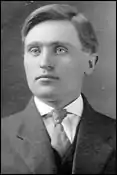Eric Wickman
Carl Eric Wickman (born Erik Wretman; August 7, 1887 – February 5, 1954) was the founder of Greyhound Lines. [1]
Eric Wickman | |
|---|---|
 Carl Eric Wickman | |
| Born | August 7, 1887 |
| Died | February 5, 1954 (aged 66) |
| Nationality | Swedish |
| Other names | Erik Wretman (birth name) |
| Known for | Founder of Greyhound Lines |

Sculptor Arvid Backlund
Background
Wickman was born Erik Wretman at Martisgården, a family farm located near the small village of Limbäck in the parish of Våmhus, 15 km north of Mora in the province Dalarna, Sweden. He was the son of the farmer Karl Viktor Wretman (1858-1947) and Anna Matsdotter (1862-1943). He was the eldest of five siblings. He was commonly known called "Martis Jerk" ("Martis" refers to Martisgården and "Jerk" refers to the name Erik).
He changed his name to Carl Eric Wickman in 1905, when he arrived in the United States as a Swedish emigrant.[2] His father Victor had earlier used the surname Wickman when he worked in the United States.
Career
Wickman worked in a mine as a drill operator in Hibbing, Minnesota until he was laid off in 1914. In the same year, Wickman became a Hupmobile salesman as a partnership-owner. When he could not sell the first Hupmobile he received, he began operating a livery route from Hibbing and Alice, Minnesota. By using the seven multi-seat Hupmobile, he drove his former colleagues between the mines and homes. This was the start of what would later become the largest bus line in the United States, renamed "Greyhound Lines" in 1914. [3] [4]
In 1925, he bought a small line operating out of Superior, Wis., that was owned by Orville Swan Caesar (1892-1965). Within a year the duo formed Northland Transportation Company. The company formally changed its name to The Greyhound Corporation in 1930. By 1934, he had expanded to 50 buses and had revenues of $340,000. Wickman retired as president of Greyhound Corporation in 1946. In 1952 he sold his interest in the business for $960,000.[5]
Personal life
In 1916, Wickman married Olga Rodin (1897–1977). They had two children Robert (Bob) and Peggy (Margaret). In 1940 King Gustav V of Sweden awarded Wickman with the Order of Vasa, first class.[6]
He died aged 66 in 1954 and was buried at Lakewood Cemetery in Minneapolis, Minnesota.[7]
Companies founded
- Mesaba Transportation Company – 1915
- Motor Transit Corporation – 1922
- Northland Transportation Company – 1925
- Greyhound Pacific – around 1930
- The Greyhound Corporation – 1930
References
- "Greyhound Lines Inc". Store norske leksikon. Retrieved December 15, 2015.
- "Martis Jerk - Busskungen från Våmhus". Greyhound Lines, Inc. Retrieved December 15, 2015.
- "Wickman Opened a Hupmobile Dealership". Bus Digest Magazine. August 1, 2013. Retrieved December 15, 2015.
- "The Swede behind the legendary Greyhound bus". Nordstjernan. Retrieved December 15, 2015.
- Transport: Bus Race (Time Magazine, March 10, 2001)
- "Martis Jerk - Greyhound". Greyhound Lines, Inc. Retrieved December 15, 2015.
- C. Wickman Dies; Headed Bus Line (New York Times. February 6, 1954)
Additional sources
- Jackson, Carlton (1984) Hounds of the Road: A History of the Greyhound Bus Company (Popular Press) ISBN 978-0-87972-271-5
- Lundell, Kristin (2014) Busskungen- Svensken som grundade Greyhound (Stockholm: Norstedts) ISBN 978-9-11306-121-4
- Sundquist, Nils (1969) Martis Jerk, Eric Wickman 1887-1954: Våmhuspojken Som Blev USA:s Busskung (Malung: Malungs Boktryckeri AB)
Related reading
- Lewis, Anne Gillespie (2004) Swedes in Minnesota (Minnesota Historical Society Press) ISBN 978-0-87351-753-9